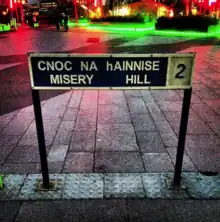 Street sign on Misery Hill | |
  | |
| Native name | Cnoc na hAinnise (Irish) |
|---|---|
| Namesake | Probably named for the public display of hanged corpses from Baggot Street's gallows |
| Length | 160 m (520 ft) |
| Location | Dublin, Ireland |
| Postal code | D02 |
| Coordinates | 53°20′40″N 6°14′22″W / 53.34439°N 6.23946°W |
| West end | Macken Street, Hanover Street East |
| East end | Forbes Street, Grand Canal Quay, Hanover Quay |
| East | Hanover Quay |
| West | Macken Street |
Misery Hill (Irish: Cnoc na hAinnise)[1] is a street in Dublin, Ireland, near Grand Canal Dock.
Location
Misery Hill is located near Grand Canal Dock. It is partly a one way street leading from Macken Street to Grand Canal Square. It runs along the northern aspect of the Bord Gáis Energy Theatre.[2]
History
The most common theory of the origin of the name Misery Hill is related to the display of corpses of those hanged at Gallows Hill near Baggot Street on this street.[3] Corpses could be left on display for up to 12 months.[4] This practice was recorded as late as 1766, with the display of the corpses of two pirates being placed there. The practice ended with the opening of the College of Surgeons. In 1803, two associates of Robert Emmett, John Begg and James Byrne were hanged on Townsend Street, but some oral sources claimed they were executed on Misery Hill.[5]
In medieval Dublin, during the 1200s, the area was a departure point for lepers leaving Ireland to go on pilgrimage to Camino de Santiago.[5] The area between Misery Hill and Lazer Lane was occupied by a hospital for the pilgrims, dealing in basic first aid for those in lower social classes. The care provided was so basic as to be called "miserable", and this is another theory as to the etymology of Misery Hill.[6] Architectural historian, Paul Clerkin asserts that those suffering from leprosy that could not gain admittance to the leper hospital at Hawkins Street would live in this area, at a remove from the main city.[4]
In the 20th century, the area around Misery Hill was industrial, with stores, and a large gasometer on Sir John Rogerson's Quay.[7] In the late 20th and early 21st century, the area was completely redeveloped as part of the wider Dublin Docklands. The headquarters of Facebook in Europe are on the corner of Misery Hill and Macken Street.[2]
Literary influence
The poet David Wheatley's 2000 collection of poetry is entitled Misery Hill, with the street being the starting point for his Joycean inspired modern journey through Dublin.[8]
References
- ↑ "Cnoc na hAinnise/Misery Hill". Logainm.ie. Archived from the original on 31 October 2015. Retrieved 22 November 2021.
- 1 2 Paul, Mark (11 September 2020). "Silicon Docks: Where the streets have no people". The Irish Times. Archived from the original on 28 September 2020. Retrieved 22 November 2021.
- ↑ Lynskey, Rory (3 April 2019). "Explaining some of Dublin's strangest street names". DublinLive. Archived from the original on 8 May 2021. Retrieved 22 November 2021.
- 1 2 Clerkin, Paul (2001). Dublin street names. Dublin: Gill & Macmillan. p. 125. ISBN 0-7171-3204-8. OCLC 48467800. Archived from the original on 25 September 2021. Retrieved 22 November 2021.
- 1 2 Thomais, Eamonn Mac (1969). "Seven Hills of Dublin". Dublin Historical Record. 23 (2/3): 86–94. ISSN 0012-6861. JSTOR 30087169. Archived from the original on 22 November 2021. Retrieved 22 November 2021.
- ↑ Hedderman, Zara (3 October 2018). "Double Take: The little-noticed laneway called Misery Hill in Dublin". TheJournal.ie. Archived from the original on 12 August 2021. Retrieved 22 November 2021.
- ↑ "Dismantling The Gasometer". RTÉ Archives. Archived from the original on 7 May 2021. Retrieved 22 November 2021.
- ↑ Brown, Richard, ed. (2008). A companion to James Joyce. Malden, MA: Blackwell Pub. p. 355. ISBN 978-1-4051-7753-5. OCLC 244174719. Archived from the original on 22 November 2021. Retrieved 22 November 2021.